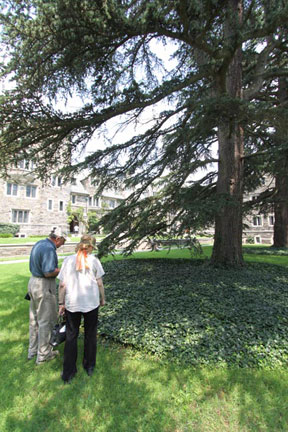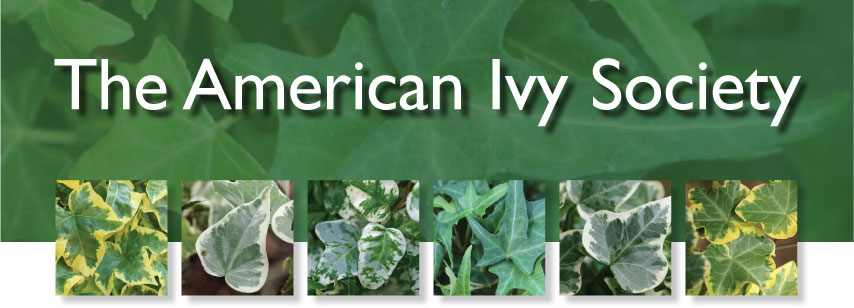Princeton….
In an Ivy League of its own.
By
Suzanne Pierot, President of The American Ivy Society
There is controversy about where the title “Ivy League” comes from. It certainly denotes a group of prestigious universities. But is it because each of those colleges was covered in ivy OR because there were four of them – like the Roman numeral IV – (Harvard, Yale, Princeton and the University of Pennsylvania)?
*See footnote below.
But Princeton, the fourth oldest college in the United States, not only has the real ivy – Hedera – climbing on buildings, they also know which variety is growing there.
Others mainly planted Boston ivy (Parthenocissus tricuspidata) which isn’t ivy at all, and learned to their dismay that it was hard to control its growth and had to tear it down. In September1982 our Ivy Journal reported that Harvard was stripping the ivy off the walls of campus buildings. We asked them for more details, and with their response sent us a sample of their “Ivy”. The prolific plant at Harvard was Parthenocissus.
Last month we asked Peter Salino, Director of the Grounds Dept. at Cornell University if they had ivy growing there. His tongue in cheek reply was: “Yes, we at Cornell have Ivy – lots of it – we have English, Boston, Virginia and even some Poison.”
Today the ivy growing on the walls of Princeton’s Nassau Hall is so neat, so perfectly in control, that it makes a joke of the critics who complain that ivy destroys brick or is invasive.

In 1866 planting an ivy beneath the wall of Nassau Hall became part of each graduating class’s tradition as they also placed a plaque in the wall with the date of their graduation. (Figure 2).
Nassau Hall, now the University’s main administrative building – originally completed in 1756 - was the temporary home of the Continental Congress where it first learned the British had signed a peace treaty granting independence to its former colonies. When built it was the largest stone structure in the colonies. After several fires in 1802 and 1855 only the exterior walls were left standing and the building we see today was created.
But it isn’t only Nassau Hall that is covered in Ivy. Ivy is everywhere at Princeton on buildings and walls. It is even used as a ground cover under trees to delineate an area where students are not to sit. (Figure 3). This tree, a Cedar of Lebanon has an under planting of H. helix at least 25 years old.


The home of the Dean of the Graduate School, Wyman House, is covered in ivy – not only on the main building - but even on the wall that separates the house from the parking lot. (Figure 4), (H. helix ’Pedata’).
The guiding hand for the incredibly beautiful plantings that give Princeton’s grounds such character is James (Jim) W. Consolloy, Manager of Grounds, who has worked there for 20 years and has 40 full time employees. Jim explained to Rachel Cobb, our editor who took these pictures, and me, that he smiles when he hears stories of how difficult it is to control ivy. “We cut our ivy back once a year starting in July and continuing into the next growing season.” He pointed to the ivy (H. helix ‘Baltica’) on the south side of Thomson courtyard, part of the Graduate College dorms. (Figure 5). “This is how it looks before it is trimmed. Look carefully and you will see where it was cut back the previous year.”



At Procter Hall, Jim pointed out the ivy with its strong trunk growing by the wall (Figure 6 – H. helix ‘Angularis Aurea’) which he believes was planted ca. 1930.
“When we need to repoint the buildings”, he explained, “we cut the ivy back to about 20 feet tall and tie it to the scaffolding that the masons work on during the re-pointing. We re-attach it using galvanized eye bolts into the stonework with plastic cable ties to hold it close to the building. The stone on this building didn’t need to be re-pointed until 1994 and the work was finished early in 1996, just in time for the 250th anniversary of the University.“
Our archives have yielded the fact that not only planting ivy on Nassau Hall became part of the 1866 graduating class’s final Class Day celebration. The Class Day exercises also included band music, the singing of an Ivy Song, and an Ivy Oration, all of which accompanied the planting of ivy.
“Our vine of friendship has fixed her roots deep in the soil of mutual esteem. We are its branches, and though now we separate … all our paths lie up one wall of knowledge”.
Nassau Herald 1866
